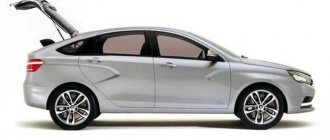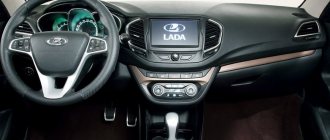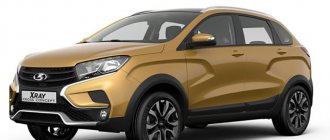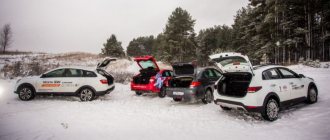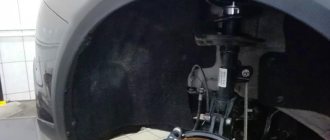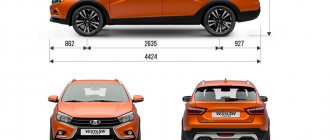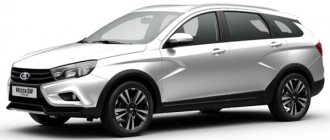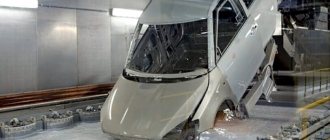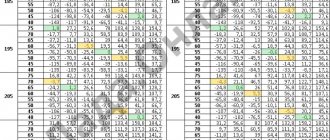The intrigue with the release of the new Lada line began with the demonstration of the Lada X Ray prototype. In principle, this model should have appeared first. But for a number of reasons Vesta became a pioneer. What is the reason for this decision? It is possible that the decision was influenced by the fact that the demand for a sedan in this class was higher. The variability and diversity of the expected range of configurations will allow us to thoroughly test the domestic market.
It's nice that the company's management took their job so seriously. In general, after Bo Andersson took over the leadership, the word “for the first time” absolutely fits many events. And the original design, and spy photos, the president of the country testing the Lada Vesta, and as the crown of history, the presentation and release of the car itself. Where, again, for the first time, a world-class car was offered to a Russian buyer.
When will the all-wheel drive Lada Vesta and X Rey go on sale?
Car enthusiasts who have acquired a taste for it, after the brilliant start of the front-wheel drive sedan, are looking forward to the announced crossover and Lada Vesta 4x4. There are no grounds for mistrust. So far, the company's new policy has not disappointed consumers and there is no doubt that promises will be fulfilled. What to expect from these “charged” versions? Why are these cars so desirable? The reasons are on the surface. The power of the car, and of course the price, which promises to be reasonable. The fact that the enterprise has reached a completely new technical level can already be considered a fait accompli.
A huge amount of work has been done to introduce the most advanced production methods. And most importantly, we have assembled a team that is unique in terms of professional training. This immediately affected the build quality. Products of high production standards come off the assembly line. Car enthusiasts will also be pleased with the variety of models. The upcoming all-wheel drive Lada X Ray Cross 4x4 becomes a hit even before its release.
A similar evolution awaits Vesta. 2021 promises to be very interesting, as presentations and sales of a number of new cars are planned.
Characteristics of all-wheel drive versions of Lada
The exact date will most likely be announced in early 2021. Then they will probably announce the packaging for the first release. Many decisions will be made based on the results of an analysis of sales, wishes and requests of customers. Domestic motorists are not yet accustomed to such an attitude. Marketing research and surveys are already being conducted. It becomes clear that the demand for powerful domestic cars is great. Having abandoned the 11189 engine precisely because of its weak parameters, the front-wheel drive car of the first production is equipped with a VAZ 21129. But for a 4x4 layout this will not be enough. All-wheel drive Lada Vesta with the HR 16DE-H4M engine is a more feasible option.
The X Ray Cross will probably have a VAZ 21179 under the hood in its first release. The volume of this power unit is 1.8 liters, not much for a crossover, but this is just the beginning. We won't know all the secrets now. Surely, more complete information will appear very soon, and there will be further insider leaks in the form of videos and photographs. It will be all the more interesting to watch the development of the domestic automobile industry. Most likely, the interior will not undergo drastic changes. There will probably be improvements, but overall the interior has been decided.
The main surprises will be on the technical side. Interestingly, the Lada Vesta was placed next to the Kio Rio Hyundai Solaris. Despite the fact that Korean cars are somewhat more powerful, the overall impression in many respects is not in their favor. What competitors will X Ray fight for the buyer? In addition to being proud of the excellent design outside and inside, information about the car’s dimensions is also reassuring. Length 4315 mm. The body width is 1820 mm, with a height of 1625 mm. Short overhangs and a ground clearance of 210 mm imply high cross-country ability.
Dreams about something more: the history of all-wheel drive on a VAZ
Genes and engineers
No, the Niva is a cool car, we are not going to argue with that.
We have already covered in detail the history of this machine, as well as its unique floating incarnation, the River, we are closely monitoring the progress of modernization of the current generation and are even trying to indicate what the next generation will be like. However, Lada 4×4 New Generation (the working name of AVTOVAZ’s new SUV) is still very far from reality and, in fact, little definite can be said about it. And the current generation of Lada 4×4 remains the only option for using all-wheel drive on Lada brand vehicles. This is exactly how things have been for almost 40 years. Although this is only true for mass-produced products - nothing really came off the assembly line in Tolyatti with all-wheel drive except the Niva in all these years - except for the small-scale VAZ-2120 Nadezhda minivan, built on the Niva platform. However, the Niva, with all its advantages and once revolutionary concept, quickly ceased to be a “comprehensive” jeep (and was it even such?), satisfying all needs - Nadezhda is just one confirmation of this.
Articles / History Team Europe: how the West took part in the creation of the VAZ-2108 We have already talked about the fact that the German company Porsche took part in the creation of the first Togliatti front-wheel drive car. However, this is the extent of “Western help” and its presence in the so-called... 17497 8 11 11/22/2015
All this time, the engineers were dreaming of something more. Our story today will be about these attempts to instill all-wheel drive genes in Lada.
For the first time, it occurred to Togliatti athletes to make an all-wheel drive car, but not a Niva - before the eighties had time to jump over the equator, and the G-8 had become a production car, VAZ rally drivers had already assembled an all-wheel drive prototype with a VAZ-2108 body and a central engine. Of course, “Niva” components - in particular, the transfer case - were used in that car, where would we be without them. It was an extreme racing option, but the idea of using Niva’s “genes” in a “chisel” was returned a dozen years later - however, the concept was completely different, closer to “civilian” vehicles... Well, it’s time to let our monsters out of the cage.
Monster #1. Tarzan
The concept of the VAZ-21083-34 Tarzan was born at the AVTOVAZ Scientific and Technical Center, but in 1996, when the first publications about the car began, the author of the design, Sergei Taranov, was called “a Tolyatti resident, currently not associated with the Volzhsky Automobile Plant.” The partner responsible for the body design was the DeCon company, and the finished product was produced by the Lada-Consul enterprise, but “with the participation” of the AVTOVAZ Pilot Industrial Production. The car turned out to be interesting, and we have already told the story of Tarzan in detail, so here we will only repeat the main points and add some previously unexplained details.
The body of a front-wheel drive VAZ car (at first VAZ-21083, and later -2111 and -2112) in Tarzana ceased to be a load-bearing structural element and was mounted on an original frame made of a rectangular profile of variable cross-section. In addition to the body, two front axles from the Niva were screwed to this frame.
One was placed in front, and was driven from a standard Nivov transfer case, which, in turn, was connected to a standard longitudinally mounted Nivov power unit. The second front axle of the Niva, rotated 180 degrees, was installed at the rear and “joined” to the transfer case via a cardan drive. This resulted in a frame SUV with independent suspension and all-round disc brakes, with maximum use of standard components and assemblies.
1 / 6
2 / 6
3 / 6
4 / 6
5 / 6
6 / 6
Articles / History Delight, disgust and off-road - the difficult path of the Lada Tarzan In the “dashing nineties”, many interesting projects were made based on VAZ models, most of which were destined to remain only projects. Convertibles, landaulets, limousines - whatever... 24547 8 24 01/05/2016
The “underwear” sticking out from below (that is, the frame) was covered with a body kit: on the first Tarzans these were massive plastic bumpers and sills, and on the bodies of the “tenth” family they were replaced by a protection kit made of welded pipes. The interior replicated the interiors of front-wheel drive vehicles, with the exception of three transmission control levers inherited from the Niva.
Tarzans were made only to order, so during the entire production period (from 1997 to 2004) only about 600 cars of all modifications were assembled, including Tarzan-UTS for public utilities. Journalists who tested the car spoke very positively about it, noting its spectacular appearance, increased comfort compared to the Lada 4×4, and high cross-country ability.
There were also disadvantages: a high center of gravity, transmission noise and vibrations, the high complexity of repairs caused by the presence of the frame... As an alternative engine, the Tarzans were equipped with a Peugeot diesel engine with a power of only 75 hp. s., but with a high torque that cut off the studs of the standard Nivov gearbox, and the diesel engine itself had difficulties with repair due to rare spare parts... Tarzan remained a small-scale, rather even a piece product. A kind of bright, but strange hybrid, a side link in the evolution of VAZ technology. It's a pity - Tarzan definitely had potential.
Monster #2. Victoria
Around the same time as Tarzan, another version of the all-wheel drive “chisel” appeared in Togliatti, and also, as they say, non-factory. An office called “Metallic-Quatro” began installing transmissions from Volkswagen Golf Syncro on VAZ-21099 sedans. The first “civilian” model appeared in 1996, although the scheme using components from the all-wheel drive Golf Syncro had already been successfully tested by cross-country athletes for several years by that time.
1 / 3
2 / 3
3 / 3
All that was needed to transform the peaceful “nine-nine” into an all-wheel drive “rogue” was, in fact, the “carcass” of the source, donor units and two days of skilled labor.
The car became known under the names VAZ-21099 4x4 Victoria and Lada Victory.
During the transformation process, the VAZ-21099 was “implanted” with a power take-off gearbox (or bevel gearbox), a rear gearbox, a viscous coupling and a rear suspension on oblique arms from Syncro. The right front axle shaft of the “ninety-nine” was slightly shortened, the left one remained standard, and axle shafts from the Niva were used at the rear to transmit torque to the wheels. From the transfer case to the rear gearbox, the torque was transmitted using a chain “the right axle shaft of the VAZ-2108 – the intermediate shaft on elastic supports of the VAZ-2101 (roughly speaking, a piece of the “classic” cardan) – the left axle shaft of the VAZ-2108.”
With the “bourgeois” gearboxes and viscous coupling, all this equipment was connected with the help of CV joints from the G8 and Niva. The rear suspension, stabilizer and gearbox were placed on the original subframe, as a result of which the tank was moved back and increased to 60 liters, but the spare wheel niche disappeared from the trunk. It was for layout reasons that the developers chose a sedan with a longer rear end than the hatchback as a test of the pen.
|
|
A viscous coupling with silicone liquid, the viscosity of which depends on temperature, connected the “back” when the front wheels were slipping. Externally, the car was no different from the production car except for the “Victoria” and “4×4” nameplates, a spoiler on the trunk lid and 14-inch alloy wheels, but off-road and in high-speed turns it surprised onlookers and rare representatives of the writing fraternity. who managed to drive it. Pleasant “bonuses” for all-wheel drive were a forced engine, a gearbox with changed gear ratios, as well as optional “sports” suspension struts and a reinforced clutch basket...
There was only one problem with the Victoria: the price list for the conversion was $6,500, which almost doubled the price of the car compared to the original, and according to some estimates, real Victorias were sold for about $20,000. Despite all the awesomeness of the resulting device, they were willing to pay that much few. It is known that in addition to the VAZ-21099, Victoria was also assembled in the back of the VAZ-2112 and was even delivered to Europe, but the matter was limited to single copies.
Monster #3. Eleventh 4x4
By the end of the 1990s, it began to dawn on the inert depths of AVTOVAZ that this was “w-w” for a reason, and all-wheel drive “sub-Jeeps” were a global trend. In the end, enthusiastic engineers inside the plant managed to push through the all-wheel drive VAZ-2111 project. In 1999, information appeared about a station wagon assembled at AVTOVAZ according to a recipe similar to that described above: the rear suspension, rear gearbox and viscous coupling were from Golf Syncro, but the power take-off gearbox was its own.
In the photo: Lada 111 GTI 2.0 4×4 (21116-04) '2001
It immediately became clear that the recipe was good, but still expensive, and AVTOVAZ STC specialists began to consistently reduce the cost of the design, and quite successfully: they developed their own rear gearbox, and even an original double-lever on a separate subframe. Thus, only the GKN viscous coupling remained borrowed.
In addition, the developers “played” with ground clearance; on various prototypes of the all-wheel drive “Eleventh” it gave an increase from 10 to 20 mm over the standard value. The cars were equipped with various engines - there were “budget” options with 1.5-liter eight-valve engines, and charged versions with a two-liter 150-horsepower Opel X20XEV engine, like the VAZ-21106.
In the photo: Lada 111 GTI 2.0 4×4 (21116-04) '2001
At least a dozen prototypes were built, some of which participated in numerous exhibitions and car shows. Development lasted more than ten years, manufacturers worked on reducing the price of the car to $8,500 (which is only a third more expensive than the serial 2111) and developing an all-wheel drive modification in small-scale production.
In the photo: Lada 111 GTI 2.0 4×4 (21116-04) '2001
However, none of the versions of such a “civilian” all-terrain station wagon VAZ-2111 4x4 began to be produced. All-wheel drive at AVTOVAZ became the domain of the Forced Testing Department, which created the hurricane Lada 112 VK S2000 Rally, and even then not for long...
Monster #4. Kalina 4WD
Mid-2000s. Those were the years when at AVTOVAZ it was still possible to do something other than projects that had an unambiguous deadline and a date for launching into production. Therefore, despite the lack of obvious prospects, the project of a small-scale all-wheel drive station wagon continued to live. In 2007, at the Moscow Motor Show, AVTOVAZ presented a prototype of the Lada Kalina 4WD. The transmission of this car itself was presented as a separate exhibit - nothing fundamentally new, however, it did not represent anything.
The only serious difference from the previously mastered schemes was that the same GKN viscous coupling was not located at the rear axle, but approximately in the middle between the front and rear axles. An original power take-off gearbox was attached to the standard gearbox, the shaft from which transmitted torque to the viscous coupling, and then the exact same shaft transmitted it to a standard Nivov gearbox, installed together with the original double-wishbone suspension on a subframe. To accommodate the subframe, the engineers had to reshape the gas tank and move the spare wheel niche close to the rear bumper, but the option turned out to be successful and for a long time was considered the crown of evolution of all-wheel drive at AVTOVAZ.
Lada Kalina 4WD Experienced (1117) '2007
However, this car did not become mass-produced - the times of dreamers and enthusiasts at AVTOVAZ never came - rather, on the contrary, the Lada brand entered the era of pragmatism. Once again there was no money for an all-wheel drive station wagon, no matter how fans of the brand asked for it - the amount of alterations in any case turned out to be too great.
In 2014, AVTOVAZ launched a rather successful Kalina Cross car, which is currently equipped with a wide range of options and even a robotic gearbox, but, alas, only has front-wheel drive. The Kalina Cross (like its “sister”, the larger Largus Cross station wagon) does not have all-wheel drive versions and is not planned.
Monster #5. Autoproduct Cross
And therefore, it is not surprising that the topic of all-wheel drive again “flowed over” to private companies. This time, the troublemaker was the Togliatti company and its founder Alexander Baburin, who previously worked at AVTOVAZ under the supervision of chief designer Vladimir Guba (formerly a famous motorsports driver) and participated in the creation of all-wheel drive vehicles based on the “tenth” family and Kalina, described above. In 2014, Avtoprodukt presented to the public its vision of the Kalina Cross car, and almost simultaneously with the presentation of the factory model with the same name - to the public disapproval of AVTOVAZ officials.
1 / 5
2 / 5
3 / 5
4 / 5
5 / 5
The car from “Avtoprodukt” - unlike the “purely VAZ” one, was not a station wagon, but a hatch - it showed off at several local motorsport events, but made a splash throughout the entire Russian automotive community. Like the factory Kalina Cross, the Baburin car was single-wheel drive, but the front and rear suspensions (both McPherson) were mounted on subframes, and all the hardware was developed independently by Avtoprodukt.
The rear subframe was designed to accommodate all-wheel drive, and the creators announced the imminent construction of 4x4 versions. And the advantage compared to the “stock” one, which was noticeable even on a single-wheel drive car, was improved handling: due to the modified suspension kinematics, an anti-dive effect arose and stability in corners increased.
In the photo: In the photo: Lada Kalina Cross
As of 2021, Avtoproduct is alive and well, but it practically does not build all-wheel drive vehicles. We know for certain about one car (a Lada Kalina station wagon, even of the first generation) with an “Autoproduct” suspension and all-wheel drive, made according to an almost canonical recipe - using VW Golf Syncro units, as well as axle shafts and CV joints from VAZ front-wheel drive and Niva.
This car, as usual, became the property of Tolyatti athletes, because, in fact, it was built according to their order. Probably, such tuning, if desired, can be ordered by a “mere mortal”, but it will be a one-piece and expensive product. At the moment, it seems, there is neither a more or less formalized concept for reducing the cost of design, nor the capacity for small-scale production. And Avtoprodukt has clearly shifted the vector in development and production from all-wheel drive to handling - suspension kits are offered for order on the company's official website.
What's the result?
This whole story shows us at least two things. Firstly, all these years, some Lada buyers desperately wanted to get a car with cross-country ability close to an SUV or crossover, and with comfort different from the Niva. There was demand, and there was always supply, more or less successful, and often almost piecemeal.
Secondly, this proposal always came not from the car manufacturer, but from third-party companies, while AVTOVAZ for many years was only trying to launch a similar product. Obviously, there should be some kind of all-terrain vehicle with all-wheel drive in the Lada line, but for the Volzhsky Automobile Plant, at least as we have known it for the last twenty years, this is a very difficult task.
However, “the last twenty years” is not an entirely accurate expression, because we have been observing very serious changes at AVTOVAZ for more than two years now. Yes, there are plenty of problems, but one cannot help but notice that there has been a huge leap in the pace of development of new models and modifications of Lada.
It has been repeatedly stated that an all-wheel drive version will be offered on the Vesta or Xray models, and maybe on both at once. There is no clarity yet, but it is known that for Xray engineers considered two concepts, borrowed and their own, and work on all-wheel drive for Vesta was confirmed in April 2021.
In any case, it will be something that has nothing to do with the previous Lada front-wheel drive vehicles and the platform, the evolution of which began with the VAZ-2108 model - that is, it will not be in any way connected with previous developments. It will be something completely new, although the general “recipe” will probably resemble something described in this article.
Many questions will be resolved during the Moscow Motor Show, which will open in August 2021. And if some all-wheel drive car is nevertheless presented at the Lada stand, this time there is a good chance that it will not remain just another concept. AVTOVAZ has recently become accustomed to keeping serious promises and has accustomed motorists to this.
Let’s hope that the transition from one-off “monsters” to a serial product will still happen, and the topic of all-wheel drive Lada will soon cease to be a dream about something more.
Survey
Do you think AVTOVAZ will produce a modern all-wheel drive car?
Your voice
Total votes:
Possible modifications of all-wheel drive Lada cars
The popular Renault Sandero Stepway and Duster models are often cited as competitors. But X Ray is more compact. So it will win in cross-country ability, which is very important for the Russian car enthusiast. AVTOVAZ President Bo Andersson has already announced that production of the X Ray will begin in early 2021. The Cross modification will be launched a few months later. This man does not waste words and no one doubts that promises will be fulfilled on time.
According to the production manager, Russians are expecting 4 versions of X Ray Cross. Which ones exactly will be known very soon. By this time, information about the all-wheel drive Vesta may appear. Then it will become known about other details and characteristics of the machines. In the same year, it is planned to expand the body series with a station wagon. The hatchback will appear a little later. Perhaps even in a year. This is explained not so much by production problems, but by the priority determined by the requests of potential buyers.
More details about Lada “Vesta” cars
Changes to the exterior and interior
Let's start with the appearance. Like Cross models of other lines, a distinctive feature of the off-road version is a protective body kit. X-Ray Cross got it too. Additionally, the designers slightly redesigned the front end.
The designers slightly stylized the chrome inserts on the bumper and side niches. Its bottom is now decorated with a black protective overlay, on top of which a curved silver skirt is placed.
The wheel arches, sills and bottom of the doors have wide black plastic linings that fit quite well into the appearance of the car.
The obvious differences between the rear of the Cross and the base X-Ray include slightly modified rear lights, a massive trim on the rear bumper with a silver insert, a black spoiler, and a “fin” on the roof. The off-road model also acquired roof rails, which were so lacking in the regular version.
It is noted that this version has increased ground clearance, which in the base model was already considerable - 195 mm. Now it is indicated that it will exceed 200 mm, although the exact figure has not yet been indicated. Note that the ground clearance has been increased for the most part thanks to the new 17-inch wheels that will be equipped with this car.
As for the remaining overall dimensions - length, width and height, if they differ in the Cross version from the regular version, it will be only slightly and due to the same body kit.
Next is the interior. There are also innovations in the cabin, but not many. In the presented concept, the interior was decorated with linings and inserts in body color on the front panel, door panels, and seats.
The designers also thought of installing a central armrest, which is not even optionally available in the basic version.
Another distinctive feature is the backlighting of the dashboard in the body color and the door sills with the version name.
But we note that all these features are present in the concept, and whether mass production models will receive them is still unknown.


